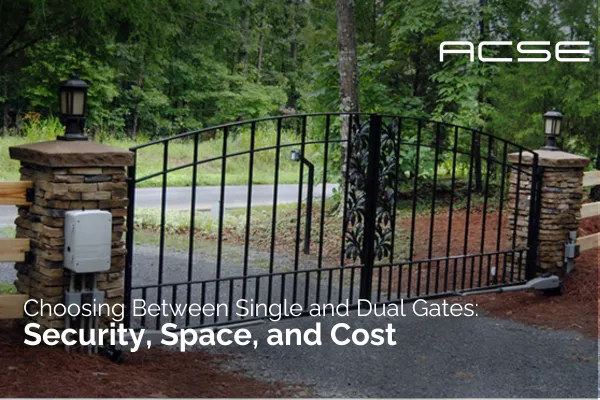
Choosing Between Single and Dual Gates: Security, Space, and Cost Considerations
When planning an automated gate system, one of the most fundamental decisions you'll face is whether to install a single-leaf gate or a dual-leaf (bi-parting) gate. Though it may seem like a simple choice, the decision impacts more than aesthetics—it affects performance, security, space usage, long-term maintenance, and total cost of ownership.
This article explores the key differences between single and dual gate configurations, helping property owners, HOAs, business managers, and design professionals choose the most suitable option for their project.
Understanding the Basics
Single Gate: A one-leaf gate that swings or slides to one side when opening.
Dual Gate (Bi-Parting): Two leaves that open from the center, either swinging outward/inward or sliding in opposite directions.
Each has its merits, depending on the layout, usage patterns, and security needs of the property.
Space Considerations
One of the first things to evaluate is your available space—both in terms of width and depth.
Single Gates
Ideal for narrow entrances.
Require more space to swing fully if not sliding.
If sliding, the gate needs enough room along one side to fully retract.
Dual Gates
Divide the swing or slide space in half, making them easier to use in tighter driveways or with landscaping.
More efficient in locations with limited side clearance.
Useful where terrain makes wide single swings difficult (e.g., hills, slopes).
Tip: Dual gates reduce the arc or track length, which is critical on properties with short setbacks.
Structural Load and Gate Weight
Gate size and material influence the choice between single and dual.
A single large gate leaf is heavier, putting more strain on hinges, motors, and posts.
Bi-parting gates split the load, often extending the life of automation components.
Heavy ornamental or metal gates often benefit from being divided to improve gate operator longevity and reduce wear.
Automation Options and Equipment Costs
From a mechanical and automation standpoint, each setup requires specific hardware:
Single Gate
Requires one operator (swing or slide motor).
May need stronger components due to increased torque and weight.
Lower upfront costs for materials and installation.
Dual Gate
Requires two synchronized operators.
Increased cost for gate operators, control boards, and wiring.
May add complexity, but improves balance and performance.
Key Consideration: Dual gate systems often require more precise setup, but distribute force more efficiently.
Security Implications
Security is one of the primary drivers for automated gates, and your choice of configuration affects it.
Single Gates
Fewer moving parts means less potential for malfunction.
Easier to reinforce structurally as one solid panel.
Dual Gates
Offers redundancy: one gate may function if the other fails.
Greater potential for manual access if not properly locked or synced.
Security is more about implementation quality than gate type—but each presents unique challenges.
Aesthetic and Visual Impact
Curb appeal matters, especially in residential and commercial settings.
Single gates often create a bold, uninterrupted look that complements modern architecture.
Dual gates deliver a classic, symmetrical appearance that blends well with traditional and upscale designs.
Both can be customized in terms of material, color, and finish—but symmetry often wins in upscale residential settings.
Maintenance and Durability
Each system type comes with maintenance trade-offs:
Single gates may wear faster due to uneven weight distribution and torque.
Dual gates require synchronization and may involve more moving parts, but distribute stress more evenly.
In both cases, regular maintenance of gate operators, sensors, and hinges is key to long-term reliability.
Use Case Examples
Here’s how property types may align with one choice over the other:
Urban Home with Narrow Driveway: Single swing or slide gate, space-saving and simple.
Luxury Estate with Large Entry: Dual swing gate for symmetry and balance.
Commercial Lot with Constant Access: Dual slide gates for speed and reliability.
Warehouse or Industrial Access: Single heavy-duty slide gate for straightforward access control.
Cost Comparison Overview
Feature Single Gate Dual Gate
Equipment Cost Lower (1 motor) Higher (2 motors)
Installation Time Faster Longer (more wiring)
Maintenance Lower complexity More parts to monitor
Space Efficiency Less efficient in tight spaces Better for limited setbacks
Long-Term Durability More wear on one side Better weight balance
Final Thoughts: Which Should You Choose?
There’s no one-size-fits-all answer. The best gate configuration depends on:
Available space and layout
Usage frequency and traffic patterns
Desired aesthetic impact
Budget and long-term maintenance expectations
Terrain and physical constraints
Working with a certified installer like ACSE ensures your system is specified correctly from the beginning. We evaluate your site, calculate loads, and recommend solutions based on performance, compliance, and efficiency.
Planning a new gate system? Let our team help you choose the configuration that brings together form, function, and future readiness.

